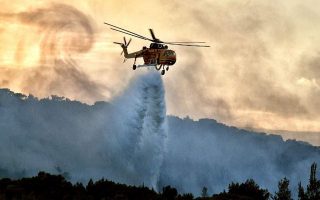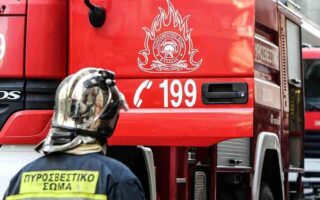Wildfires highlight island personnel shortages

In mid-June a fire started on Milos. The island’s sole firefighter headed straight to the location in an antiquated fire truck, calling the head of the volunteer rescue team on the way. “Lazaros, gather everyone you’ve got and run.” Lazaros Alexopoulos, president of the volunteer emergency team, knew what to do. “This always happens. I usually manage to get 10-15 people from the 25 of us on the team,” he tells Kathimerini.
Alexopoulos moved to Milos 14 years ago and two years later went on to create this group, which assists in any emergency that occurs, as there is no proper Fire Service unit on the island. He says two people are needed simply to operate the fire truck. In the fire in question, Milos’ only firefighter managed to position the hose using stones and then returned to the driver’s seat.
In the first hours after the blaze broke out, the islanders were basically alone, save for the one firefighter and the 14 volunteers who rushed to the scene. “Things could have gone really badly if we hadn’t been there. What we did was a feat, and we did it with the help of civilians because a second fire broke out simultaneously at the island’s landfill. There was no one to coordinate,” Alexopoulos told Kathimerini recently.
Three hours after the blaze broke out, a group of firefighters were flown in by plane, with fire trucks coming later on the regular ferry service. They were also joined by water-dropping aircraft. The fire was contained before it could cause too much damage, but the local authorities and residents feel lucky there was no other major fire at that moment, so forces could be mobilized to save their island and their properties.
In nearby Serifos, despite the help provided by firefighting forces from other parts of the country, the result was very different. The heartbreaking images from the blackened slopes of the Cycladic island highlighted the problem of understaffing in the Fire Service, both in personnel and equipment, on many of the smaller islands in the Cyclades and the Dodecanese, as well as their inability to deal with any disaster requiring a response from the civil protection mechanism, including a fire or an earthquake. The problem becomes particularly noticeable in the summer when the islands’ populations multiply and the risk of fires increases exponentially.
Manolis Mikelis, the mayor of Milos, explained that although he has taken some measures to make up for the absence of personnel and vehicles, these are not sufficient in a case like the triple outbreak that occurred at the beginning of the summer. He said the municipality has signed contracts with companies to provide fire trucks and water cannons, while it also has bulldozers thanks to a donation from another private company. “The municipality also has its own water cannon,” he says. When asked who operates it, since there is only one firefighter on the island, he answered that these tools are usually handled by officials and employees of the municipality. “The water cannon is usually operated by the deputy mayor, responsible for civil protection,” he said.
It is worth noting that the water used by Milos for firefighting is then billed to the municipality, which buys it from the desalination plant.
‘There is no fireman. There is a group of volunteers who, together with the municipality, do what they can’
The mayor of Astypalaia painted an even worse picture. “There is no fireman in Astypalaia. There is a group of volunteers who, together with the municipality, do what they can, with one water truck. In the villages, we have fire hydrants,” said Nikos Komnineas. The situation becomes even more difficult, he argued, because the distance separating Astypalaia from the other islands increases the time it takes for help to come. “Milos was lucky. But for a unit to get here with a truck it takes at least 10-12 hours. What are we supposed to do until then?” he wondered, pointing out that the island is currently hosting some 7,500 people, of which 6,000 are summer visitors.
In the case of Milos, the Fire Service is supposed to be staffed with three or four seasonal firefighters during the summer. Of those, only one showed up and he is currently on leave. None of the others accepted the job. The reason is the increased cost of accommodation and living. “We could not find houses for them,” said Mayor Mikelis.
“There should have been 40 of us including the permanent staff; instead there are 32 – and the vehicles are ancient,” a seasonal firefighter serving on an island in the northern Sporades told Kathimerini on condition of anonymity
He said many firefighters do not want to come to the island, as they need to hold down two jobs just to make ends meet, usually working as waiters also. “We earn a salary of 900 euros and a room costs around 500 euros a month; a room, not even a house,” he says. Another parameter is uncertainty. After the six months they serve as seasonals, they receive an unemployment benefit and cannot easily find work for such a limited period. “We want to be made full-time,” he added.
Kathimerini understands that similar shortages are a problem on several islands despite the repeated job openings that have been published.
Individual plans
Komnineas believes that a separate plan is required for each island. The Regional Union of South Aegean Municipalities has submitted a proposal to prepare such plans. The aim is to create local units and secure vehicles adapted to the particularities of the islands, such as the narrow roads. Then, following relevant studies, authorities must reopen rural roads that have disappeared since farming was abandoned and create a network of water tanks on the islands.
Elias Tziritis, coordinator of actions for forest fires at the Greek branch of the World Wildlife Fund (WWF), said the wildfires on the islands have serious effects both on the residents and those who attempt to extinguish them, as well as on the environment itself. He explained that low vegetation does not exclude a wealth of biodiversity. “We should not only look at forests. The islands are home to populations of reptiles, amphibians and more. The small islands of the Aegean especially, are cradles of biodiversity. It has also been proven that most firefighter accidents happen in wildfires in low vegetation,” he said.
Tziritis added that one way to improve the prevention and management of fires is to strengthen volunteer firefighting groups, which mostly operate alone on the islands, without even being provided with protective gear. “They don’t even offer them gas for their vehicles, or a bottle of water,” he said, adding that the existing law should be activated so that volunteer firefighters have certain rights and protections.
Kathimerini asked the Fire Service about the understaffing on several islands. It responded that the distribution of personnel is done according to the resources and needs of the local community.
“The assessment process has been carried out every year since 1938. This year, for example, the needs were assessed and for the first time there are forestry teams in Chios. They already existed in Samos and Kefalonia,” a Fire Service spokesperson responded.





